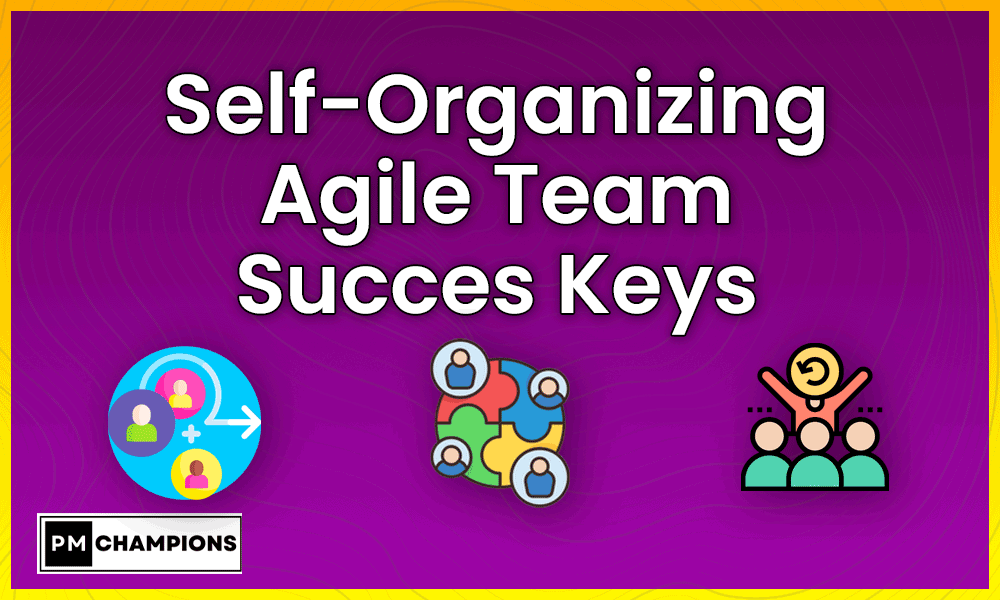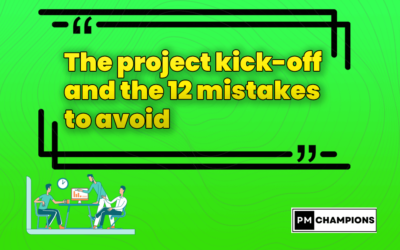
Key points
This article highlights the importance of integrating a self-managed team into an agile project. We reveal the secrets to achieving this goal, a sometimes tricky task, especially with a junior team. Keep reading till the end!
WHY A SELF-ORGANIZING TEAM?
Self-organization is the ability of a team to decide how to organize its own activities to achieve set goals or solve problems it faces.
In an agile context, the self-organization aspect of the team is a key point.
It is one of the twelve recognized and shared agile principles .
Achieve shared commitment, since the team is committed to the goal and knows how to get there.
Humanly speaking, people are more engaged when the choice of how is free, it’s more rewarding.
Avoid, operationally, having bottlenecks around people who are “experts and/or specialists” in a field.
Indeed, since it is the team that is committed, they will do what is necessary to achieve this goal.
Management and more generally all stakeholders must have confidence in the team’s ability to achieve the objectives it has set for itself.
It should be noted that this will not be a result to be expected from day one, when the team is getting to know each other, learning to work together and must have the right to make mistakes.
Working in a self-managed, agile team is like juggling unicorns – it’s magical, sometimes chaotic, but always full of surprises!
WHEN does the Agile team become self-managed?
Frequency : Throughout the life of the project
- Team self-organization is a paradigm shift to:
- Team members who have never worked in an agile context.
- But also management.
- It’s not innate and doesn’t happen by magic from the beginning of the project.
- All it takes is an accident along the way (a serious event) to break self-organization.
- Example: Delivering a low-quality sprint leading to a lot of customer dissatisfaction.
- It is therefore to be carried out throughout the project.
WHO makes the agile team self-managed?
- The Scrum Master must have a “Servant Leader” posture, to help the team to:
- Achieve your goals,
- Overcoming obstacles,
- Make the best choices (not make them for them),
- Self-organize.
- It should also help the team understand the benefits of not specialising profiles:
- Plan the work to be done more easily (leave, sickness, assignment to other projects, etc.).
- To develop the skills of the less experienced people of the team and thus motivate them so that they can evolve and give the best of themselves.
- Share progress among all team members: everyone knows what the other is doing and how.
HOW to make the agile team self-managed?
- A team organizes itself effectively if and only if
- It is motivated.
- She is responsible.
- As a Servant Leader, the Scrum Master must do everything possible to ensure that these two conditions are met.
MOTIVATING THE TEAM: THE THREE COMPONENTS OF AUTONOMY
A self-organization that works is mainly due to the unwavering motivation of the team. The three major components of motivation are purpose, autonomy, and mastery.
- The objective : it is the responsibility of the Scrum Master to ensure that the team has understood the objectives of the project, shares them and adheres to them, and above all finds a concrete and growing interest in them.
- Autonomy is a pillar of Scrum, with the basic assumption being that team members are experts who should have the freedom to decide how to build the application. And the primary directive of the Scrum Master is to protect the autonomy of the team, which in fact leads to motivation.
- The road to mastery can be long and fraught with pitfalls, which involves wanting to do your best and always looking for ways to improve. The second directive of the Scrum Master is to accept mistakes and trust the team.
EMPOWER THE TEAM
- The role of the Scrum Master/Tech Leader is not, in an agile context, to tell the team what to do, what tasks to be performed and how to do them.
- Indeed, in such a context, the role of the leader is to help the team grow and mature, so he must position himself as a Servant Leader.
- Assist with task assignments, detailed analysis, and extensive testing on behalf of the team.
- Of course, as far as possible: in the beginning, with a team with little experience in agility, the Scrum Master may have to perform some of these tasks. But it must remain exceptional, it is in his interest to coach rather than to do!
- Set constraints, limits, and ensure that the framework given corresponds to the objectives of the project.
TRUST TEAMS, EVEN WHEN THEY FAIL – AND GET THEM ON BOARD
To have an effective and autonomous team, it is sometimes, even often, necessary for the team to make bad choices, to make bad decisions.
In order to have a satisfactory result in the long term, it is necessary to go through this step.
A drop in velocity, unmanaged risks, a bad strategy at the beginning, are sometimes key success factors in the end.
- The key is to trust the project team and believe in its potential.
- The role of the Scrum Master is to:
- Make the team aware that they are responsible for their choices.
- Supporting her in her choices is the key to getting her commitment.
- In particular, the team should have responsibility for how to implement a User Story.
- This is a structuring point for an efficient self-organized agile team.
RECOMMENDATIONS
AS A MEMBER OF THE TEAM, I HAVE A DUTY TO
- Embrace change – The team is always looking for ways to improve the way they work, I have to stay open and embrace change when it comes.
- Try new things – The team engages as a group, I have to be willing to step out of my comfort zone and learn new things to help the team engage. This requires taking risks, experimenting, and helping the team work outside of my individual framework.
- Take action, instead of waiting to be told what to do – I can’t just wait for someone to tell me what to do. If I see something that needs to be done, I share it with the team and carry it out if necessary.
- Helping others succeed – If I see someone who needs help or more experience on a particular topic, I offer to assist them if I can. At the end of the day, it helps the team as a whole move forward.
- Be supportive – I shouldn’t work in my corner without giving team members visibility into my work in progress. Individual interests must take precedence over those of the team as a whole.
FOR TEAM MEMBERS
- Make decisions by consensus – The team will have a lot of decisions to make, the members will have to agree as a team on how they will make them.
- Peer coaching and feedback – The team should look for ways to become versatile and increase learning. One possibility is to coach and give feedback to each other.
- Group Problem Solving – Team members are responsible for solving problems quickly, together.
- Managing Conflict – Members will need to agree on how conflicts are resolved within the team.
- Consider that everyone is doing the best of their knowledge and abilities within the team. The performance of the team depends on the performance of all its members. Advancing individuals advances the team.
Conclusion
To sum up, leadership, in an agile context, must change in the position of assistant. Motivate, get the commitment of the teams , trust, leave room for creativity, the right to make mistakes and help them.
Frédéric Lippi (CEO of the SME Lippi) “In times of crisis, self-organisation costs less and pays off more from all points of view… »










0 Comments